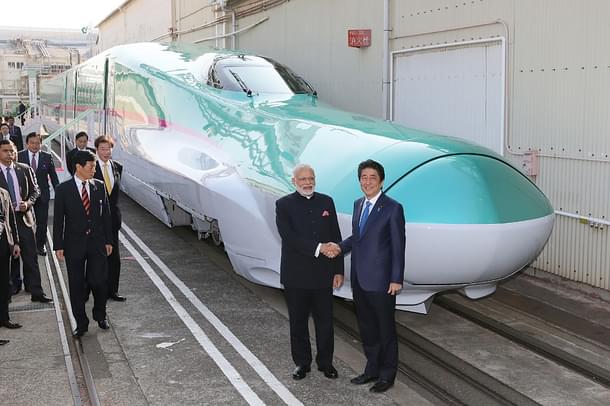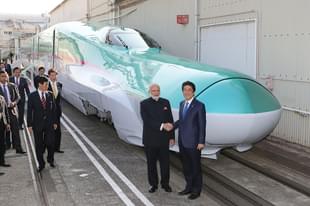Infrastructure
Five Challenges In The Ahmedabad-Mumbai Bullet Train Project
G. Raghuram
Sep 14, 2017, 10:24 AM | Updated 10:23 AM IST
Save & read from anywhere!
Bookmark stories for easy access on any device or the Swarajya app.


It is indeed a great beginning for India that the ground-breaking for the construction of the first bullet train between Ahmedabad and Mumbai is happening on 14 September at a function attended by Prime Minister Narendra Modi and his Japanese counterpart Shinzo Abe. Apart from being a major leap in infrastructure development in India, this project signifies the friendship and collaboration between the two countries.
The 534-km Rs 1 trillion high-speed rail project that will operate trains with average speeds of 200-250 kilometres per hour will be a game-changer in terms of inter-urban connectivity and establish India as a market for such technologies. Japan, which has matured in evolving such technologies and is seeking opportunities for investments, is providing a loan that would cover 80 per cent of the estimated project cost at 0.5 pre cent interest, with a 15-year moratorium followed by a 35-year payback period. While it is of great value that we have both financial and technological support from Japan for building this line, there are multiple challenges that need to be overcome. I speak of at least five:
1) Route Design Which Would Include Questions Like:
a) Detailed alignment choice, especially when it is over ground, keeping in view land acquisition challenges versus providing access to the population along the corridor. If the alignment goes closer to urban growth areas to provide access, there would be issues of land acquisition, pulling down buildings, possibility of destroying heritage structures etc.
b) Location of stations: whether they should be the city centre connecting existing railway stations, or in an adjacent station, or periphery of an urban node. The trade-offs are providing better access and connectivity versus costs due to land and structures.
From a long-term point of view, being in the periphery of an urban node, apart from reducing costs, could help generate urban growth around the station, and even in shifting the centre of gravity of the urban area. In the short run, however, traffic ramp-up will take time. This needs to be mitigated through excellent feeder services. The specific location of the terminal station in Mumbai is still courting controversies. The Maharashtra government does not seem to be willing to give land in a major commercial growth node, as has been requested. Instead, it is suggesting that the station could be located in the land that belongs to the railways. This could have implications on the catchment at the Mumbai end.
c) Number of stations: In general, there would be a demand for more stations. While this will increase the catchment, it could reduce the average speed due to higher number of stops. One way around this would be to have different service categories like fast (stopping at all stations) and super-fast (only at major cities).
It should be noted that the bigger catchment will be from the smaller cities that may not have access to airports. For example, while an Ahmedabad-Mumbai passenger may still consider air as a viable option, for the Anand-Mumbai or Ahmedabad-Vapi passenger, the high-speed train is a great boon. Having stations with connectivity to airports like at Ahmedabad, Vadodara and Mumbai will increase catchment of long distance air passengers, who could then connect to the cities in this corridor and vice-versa.
2) Evacuation Facilitation:
At each station, it would be important to have fast and multiple means of evacuation, to increase the catchment and propensity to travel.
a) To begin with, efficient bus services as well as accessible parking lots for private vehicles should be provided.
b) In Mumbai and Ahmedabad, where metros are under construction, it would be important to provide seamless metro connectivity.
c) At major stations, where passengers could move to other trains, the transfer must be seamless.
3) Land Acquisition:
This will be a critical issue, especially where the alignment would veer off from existing railway lands. The challenges would be best addressed by the line going over ground, where the actual acquisition would be limited to the footprint of the pillars. Designs would have to developed in such a way that the footprint is minimised. Experience from land acquisition for transmission lines and metro corridors would come in handy.
4) Human Resource Development:
It would be important to train a large number of Indian engineers and managers for design, construction and operations at standards that would be essential for high speed rail, including for stringent safety standards. It would also be important to train Japanese senior management, who need to spend considerable time in India to train and oversee the required activity. The Japanese managers would need to be oriented towards Indian conditions and the prevalent professional culture. In recognition of this, as part of the project, a large training centre is being put up. Along the same lines, IIM Bangalore is setting up an India-Japan Study Centre with the mission of improving India-Japan mutual understanding and complementary skill building in the domain of management including for infrastructure.
5) Future Expansion:
It would be useful to have a perspective on how the expansion of this line would happen. Once the proof of concept of high speed rail is established, there would be demands for expansion. In an earlier proposal, the line was actually to go beyond Mumbai to Pune, but was not found to be viable initially. Such visioning would be useful in bringing greater support from the government of Maharashtra.
(Mint)





